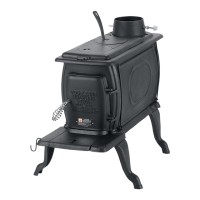
Do you have a question about the Vogelzang International BX26E and is the answer not in the manual?
| Type | Wood Stove |
|---|---|
| Heating Capacity | Up to 1, 800 sq. ft. |
| Heating Area | Up to 1, 800 sq. ft. |
| Fuel Type | Wood |
| Material | Steel |
| Efficiency | 75% |
| EPA Certified | Yes |
| Blower Included | No |
| Flue Size | 6 inches |
Comply with local codes, observe clearances, and do not install in mobile homes or trailers.
Do not modify the stove; use original parts. Ensure proper installation and no compromises.
Connect to own flue; never vent to other appliances or rooms. Do not use aluminum vents.
Ensure chimney is safe, inspected, and free of creosote buildup.
Proper handling and disposal of ashes in a steel container away from combustibles.
Handle hot stove with care, keep children away, use protective gear, and do not over-fire.
Install smoke and CO detectors; keep area clear of combustibles.
Consult local officials for permits and obtain NFPA publications for safety guidance.
Uncrate the stove, remove packing materials, and identify all parts.
Assemble stove base, attach hearth, and secure rear and front legs.
Attach damper collar, swing top, lid support, lids, and slide draft.
Install the feed door and place the S-Hook for lid lifter storage.
Carefully place stove in location, recheck clearances, and ensure proper pipe installation.
Stove must be on a proper floor protector; maintain minimum clearances from combustibles.
Connect stove to its own flue; do not connect to air distribution ducts.
Install connector pipe to a suitable chimney, following clearance and material specifications.
View diagrams and table for minimum clearances from combustible surfaces.
Attach connector pipe to stove flue collar and ensure upward slope towards chimney.
Maintain ceiling clearance, avoid pipe extension into flue, limit bends, and use proper materials.
Connector pipe must not pass through concealed spaces or combustible construction.
Connect to a lined masonry chimney; inspect and repair it before use.
Chimney must provide adequate draft and meet minimum height requirements.
Use UL 103 HT listed chimney; follow manufacturer's instructions for installation.
Converting fireplaces requires sealing, inspection, and structural soundness.
Procedure for connecting stovepipe to masonry chimney via thimble.
Clearance requirements for brick masonry chimneys passing through combustible construction.
Clearance requirements for solid-insulated, factory-built chimney sections.
Clearance requirements for sheet steel connectors with ventilated thimbles.
Clearance requirements for insulated chimney sections used as pass-throughs.
Avoid over-firing, keep combustibles away, and handle hot stove with care.
Burn wood only; use seasoned hardwood. Follow steps for starting a fire.
Add fuel in small amounts; perform initial burns to cure stove paint.
Understand creosote formation, prevent chimney fires, and follow procedures if one occurs.
Steps to reduce creosote build-up, including wood choice and burn routine.
Address draft issues and inspect chimney regularly for proper function.
Periodic maintenance for cast iron stove joints may be required.
Formulas to convert material specifications and calculate R-value for floor protectors.
System R-value must meet or exceed specifications; an example calculation is provided.
